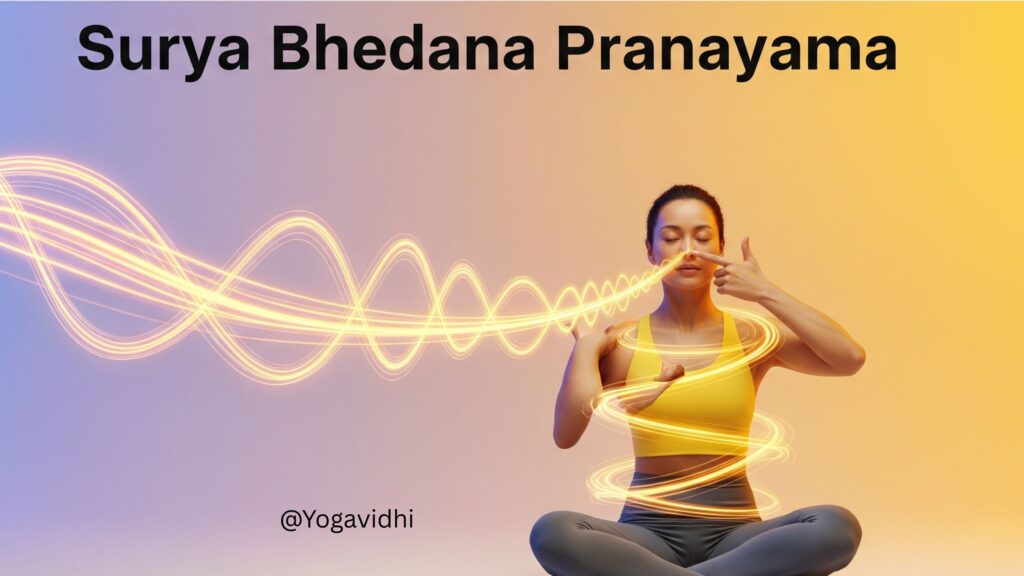In today’s fast-paced world, many of us feel drained, sluggish, or mentally foggy. While coffee or energy drinks may give a temporary boost, they often come with side effects. Yoga, on the other hand, offers a natural and sustainable way to re-energize the body and sharpen the mind. One such powerful yogic breathing technique is Surya Bhedana Pranayama.
Known as the “Right Nostril Breathing” or “Sun-Piercing Breath,” Surya Bhedana pranayama activates the solar energy within the body, awakening vitality, improving digestion, and sharpening mental focus. Unlike calming breathing practices such as Chandra Bhedana or Anulom Vilom, this pranayama is stimulating, energizing, and best for times when you need an internal recharge.
If you’re looking to increase energy naturally, balance your body’s energy channels, and harness the power of yogic breathing, this article will walk you through everything you need to know about Surya Bhedana Pranayama—its meaning, benefits, step-by-step practice, precautions, and more.
Surya Bhedana Pranayama, also known as right nostril breathing, is a stimulating and warming yogic breathing practice. It involves inhaling through the right nostril, retaining the breath, and exhaling through the left nostril while seated in a meditative posture. Using Nasika Mudra (where the index and middle fingers are folded to control the nostrils), this technique activates the nervous system, raises body temperature, and enhances vital energy, promoting vigor and overall balance in the body.
Table of Contents
Meaning and Origin of Surya Bhedana Pranayama
The term “Surya Bhedana” comes from Sanskrit:
- Surya = Sun (representing heat, vitality, energy).
- Bhedana = Piercing or channeling.
Thus, Surya Bhedana Pranayama literally means “piercing or channeling the solar energy.”
In yogic philosophy, the body contains subtle energy channels called Nadis. The right nostril is connected to the Pingala Nadi, associated with the sun, masculine energy, heat, and activity. By consciously breathing through the right nostril, practitioners stimulate Pingala Nadi, activating vitality and alertness.
Classical yogic texts such as the Hatha Yoga Pradipika describe Surya Bhedana as a cleansing and energizing practice, designed to purify the body, awaken inner strength, and prepare the practitioner for higher states of yoga.
Benefits of Surya Bhedana Pranayama
Practicing Surya Bhedana pranayama regularly can transform your physical, mental, and spiritual health. Let’s look at its wide-ranging benefits:
1. Physical Benefits
- Boosts Energy Levels – By stimulating the right nostril, this pranayama activates the sympathetic nervous system, instantly refreshing the body and mind.
- Improves Digestion – The heating effect enhances metabolism, reduces sluggishness, and helps with better assimilation of nutrients.
- Strengthens Lungs – Increases lung capacity, oxygen flow, and respiratory health.
- Warms the Body – Particularly beneficial during winters or in cold climates as it generates internal heat.
2. Mental & Emotional Benefits
- Increases Focus and Alertness – Excellent for students, professionals, and anyone who needs sharp concentration.
- Reduces Mental Fatigue – Clears brain fog and lethargy, replacing them with clarity and drive.
- Balances Mood – Acts as a natural energizer for those who feel low or demotivated.
3. Spiritual Benefits
- Activates Solar Energy (Pingala Nadi) – Stimulates masculine, dynamic energy.
- Balances Energy Channels – Helps restore balance between the sun (Pingala) and moon (Ida) nadis.
- Prepares Mind for Meditation – Though energizing, it also aligns mental focus, making meditation deeper and more stable.
Contraindications and Precautions
While Surya Bhedana pranayama has many benefits, it’s not suitable for everyone. Practicing incorrectly or without awareness may cause discomfort.
- Avoid if you have high blood pressure – The heating and stimulating effect can worsen hypertension.
- Not suitable for heart patients – Extra stimulation may strain the heart.
- Avoid during fever – As it generates heat, it can aggravate body temperature.
- Skip if you have acidity or ulcers – The heat may worsen digestive issues.
- Pregnant women should consult a yoga expert before attempting.
General Precaution: Always practice on an empty stomach, in a calm environment, and under the guidance of a certified yoga teacher if you are a beginner.
How to Practice Surya Bhedana Pranayama (Step-by-Step Guide)
Here’s a simple way to practice this energizing pranayama:
Step 1: Preparation
- Sit comfortably in Padmasana, Sukhasana, or Vajrasana.
- Keep the spine straight, shoulders relaxed, and eyes closed.
- Place your left hand in Chin Mudra on your knee.
Step 2: Nasagra Mudra
- Use the right hand to form Nasagra Mudra (thumb closes right nostril, ring finger closes left nostril).
Step 3: Inhalation (Puraka)
- Close the left nostril with your ring finger.
- Inhale slowly and deeply through the right nostril only.
Step 4: Retention (Kumbhaka) – Optional
- Hold the breath for a few seconds, only if comfortable.
- Focus on the energy rising within.
Step 5: Exhalation (Rechaka)
- Close the right nostril with the thumb.
- Exhale slowly through the left nostril.
Step 6: Repetition
- This completes one round.
- Practice 5–10 rounds initially, gradually increasing with experience.
Read More: Ujjayi Pranayama – The Victorious Breath for Calm, Focus, and Inner Strength
Read More: Bhramari Pranayama – The Humming Bee Breath for Stress Relief and Inner Calm
Best Time and Duration
- Ideal Time: Early morning on an empty stomach, when energy levels need activation.
- Duration: Beginners can start with 3–5 minutes and progress up to 15–20 minutes.
- Frequency: Once or twice daily, depending on your routine and energy needs.
Scientific Perspective
Modern science also supports the effectiveness of Surya Bhedana pranayama. Studies suggest that:
- Right nostril breathing increases sympathetic activity, making you more alert and energized.
- It enhances oxygen intake, improving brain function and focus.
- Regular practice may boost metabolism, supporting weight management and digestive health.
Thus, this ancient yogic technique aligns with scientific principles of breathwork and nervous system regulation.
Surya Bhedana vs. Chandra Bhedana
Both are complementary practices but have opposite effects:
| Feature | Surya Bhedana (Right Nostril Breathing) | Chandra Bhedana (Left Nostril Breathing) |
| Energy | Stimulating, activating | Calming, cooling |
| Nadi | Activates Pingala Nadi | Activates Ida Nadi |
| Effect | Boosts energy, improves digestion, increases focus | Reduces stress, cools the body, aids relaxation |
| Best For | Lethargy, low energy, cold weather | Anxiety, heat, stress, insomnia |
A balanced yogic practice may include both, depending on individual needs.
Common Mistakes to Avoid
- Breathing too fast or forcefully – This can cause dizziness.
- Practicing after meals – Always wait at least 3–4 hours after eating.
- Holding breath for too long – Retention should be natural, not forced.
- Ignoring contraindications – Always listen to your body’s signals.

Conclusion
Surya Bhedana Pranayama is more than just a breathing technique—it’s a powerful way to activate your inner energy, sharpen your focus, and build resilience. By practicing regularly, you can overcome lethargy, improve digestion, and cultivate mental clarity, all while balancing the body’s subtle energy system.
Incorporating Surya Bhedana pranayama into your daily yoga routine can be life-changing. Whether you’re a student seeking concentration, a professional battling fatigue, or simply someone who wants natural vitality without relying on stimulants, this practice can help you reconnect with your inner sun.
Take a few minutes each morning to breathe consciously through your right nostril, and you’ll feel the warmth of energy, focus, and vitality radiating throughout your day.
FAQ:
Q. What is Surya Bhedana Pranayama?
Ans: Surya Bhedana Pranayama, also known as Right Nostril Breathing or Sun-Piercing Breath, is a yogic breathing technique where you inhale through the right nostril and exhale through the left. It activates the Pingala Nadi, stimulates solar energy, and boosts vitality and focus.
Q. What are the main benefits of Surya Bhedana Pranayama?
Ans: This pranayama increases energy levels, improves digestion, enhances lung function, sharpens concentration, reduces mental fatigue, and generates inner heat—making it especially useful during cold seasons or when feeling lethargic.
Q. Who should avoid Surya Bhedana Pranayama?
Ans: People with high blood pressure, heart disease, fever, acidity, or ulcers should avoid Surya Bhedana pranayama. Pregnant women and beginners should practice only under expert guidance.
Q. When is the best time to practice Surya Bhedana Pranayama?
Ans: The best time is in the early morning on an empty stomach, as it energizes the body and mind for the day ahead. You can also practice it during the day if you feel tired or mentally drained.
Q. How long should I practice Surya Bhedana Pranayama daily?
Ans: Beginners can start with 3–5 minutes (5–10 rounds) and gradually increase up to 15–20 minutes per session. Regular practice once or twice daily brings maximum benefits.
Q. How do you do Surya Bhedana Pranayama?
Ans: To practice Surya Bhedana Pranayama, sit in a comfortable position with your spine straight. Using your right hand in Vishnu Mudra (or Nashika Mudra), gently close the left nostril. Breathe in slowly and deeply through the right nostril, retain the breath for a comfortable length of time, and then exhale fully through the left nostril. Continue this pattern—inhale from the right, exhale from the left—for several minutes, maintaining a calm and steady flow of breath.
Q. What are the benefits of Suryabhedana pranayama?
Ans: By stimulating the Surya Nadi, this practice infuses the body and mind with warmth, brightness, and clarity. It strengthens digestion, ignites inner energy, sharpens concentration, and fosters a state of vitality that benefits both daily activities and yoga practice.
Q. Which disease can Surya Bhedana Pranayama cure?
Ans: Surya Bhedana Pranayama helps relieve respiratory issues such as asthma, cough, and other related conditions.
Declaration Note:
We use third-party videos and images on https://yogavidhi.com/ for educational and illustrative purposes. All rights belong to their respective owners. No copyright infringement is intended.



